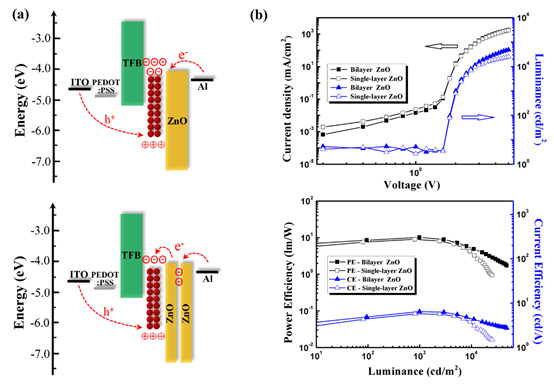Recently, Prof. Zuliang Du’s group reported a simple method to balance the carrier injection of quantum dots light-emitting diodes (QLEDs). By twice spin-coating and annealing the ZnO electron transport layer (ETL) separately, a defect interface was introduced into the ZnO ETL, which effectively blocked the excess electrons to reduce exciton quenching, electrification of QDs and efficiency roll-off of devices. The research is published inNanotechnology 29 (2018) 485203(SCI, IF=3.404).
http://iopscience.iop.org/article/10.1088/1361-6528/aae0b8

Figure 1. (a) Flat-band energy-level diagrams of the QLEDs; (b). Current density–voltage, luminance–voltage and Luminance versus efficiency curves of QLEDs with double logarithmic coordinates
Unbalanced carrier injection is one of the most important reasons for the efficiency roll-off in QLEDs. Reducing the electron injection can effectively balance the carrier transport and improve the optoelectronic performance of the device. Previous research in this field always involved more functional layers into the device. This will form a new contact interface between different materials within the device, resulting in too many factors affecting the carrier transport, which does not help to understand the mechanism of injection imbalance effect affecting device performance. In this work, using the interface barrier, a simple method was presented to control the electron injection to balance its transport with the hole injection. By twice spin-coating and annealing the ZnO ETL separately, a defect interface was introduced into the ZnO ETL, which effectively blocked the excess electrons to reduce exciton quenching, electrification of QDs and efficiency roll-off of devices. This method does not use more additional materials and does not involve contacting with other functional layers. The results show that more than 60% of electrons are effectively blocked by the ZnO interface barrier compared with the standard device, resulting in increasing the maximum luminance of the device from 25 390 to 48 220cd m−2and the current efficiency from 1.5 to 3.2cd A−1.